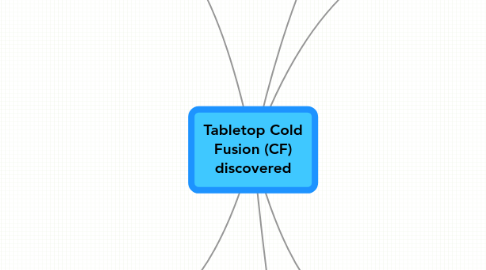
1. Economic Growth
1.1. Immediate impact (0-10 yrs)
1.1.1. Lots of investment are necessary to build up CF capacity
1.1.2. Some industries will start investing today to profit from expected lower energy prices in 5/10 years
1.1.3. Positive impact, even before CF is available
1.1.3.1. Global growth = higher consumption of industrial materials
1.2. Long term impact 10 yrs +
1.2.1. Actual macro impact of CF : decreases in electricity prices and oil prices
1.2.1.1. Cheaper energy = more growth
1.2.2. Analogy with discovery of oil
2. Investments
2.1. Palladium and Nickel are the new oil (increase in value, become strategic resources)
2.1.1. Nickel : common metal, quantity needed probably low, no economic or strategic impact
2.1.2. Palladium : Expensive and rare metal
2.1.2.1. Long palladium. Crowded trade, but rationale is strong, and it did work in 1989.
2.1.2.2. Long palladium miners. Crowded trade too, but still good enough to be tried.
2.2. Change in expectation in other industries
2.2.1. Automobile
2.2.1.1. Ready for Electric cars
2.2.1.1.1. Renault
2.2.1.1.2. Toyota
2.2.1.1.3. Smaller companies
2.2.2. Oil 'n Gas
2.2.2.1. Today : not much impact on Oil supply / demand equation. However, we can expect lower demand for oil in 10 years
2.2.2.1.1. Not tradeable
2.2.2.2. Oil investment will decrease significantly, as oil companies prepare for a future will lower oil demand
2.2.2.2.1. Short Oil exploration / Oil equipment
2.2.2.3. Oil companies : will have to choose between shrinking and becoming gasoline supplier, or to expand their business, using their cash reserves to become major players in CF
2.2.2.3.1. Stockpicking opportunity, not sector bet
2.2.3. Renewable energies
2.2.3.1. Stop being cool, stop being important
2.2.3.1.1. Short solar panels, Short wind generation, Short Biofuels
2.2.4. Water
2.2.4.1. Desalination becomes economic reality, as it consumes a lot of electricity
2.2.4.1.1. Long desalination companies
2.2.4.1.2. Good news for drought prone countries : Australia & South Africa
2.2.5. Coal
2.2.5.1. As a resource, coal will slowly slide into irrelevance, as it is perfectly replaced by cold fusion. Shorting coal futures probably not a good idea, equity of miners a better idea
2.2.5.1.1. Short coal mines
2.3. Current technologies that will benefit of lower energy (mostly electricity) prices, and need long-term investments ?
2.3.1. High speed trains become an ideal mean od transportation, as operational costs are reduced
2.3.1.1. Electric trains manufacturers
2.3.1.2. Long Steel (global economy + track building)
2.3.2. Metal refining - uses a lot of electricity (Steel 15/20% of the cost is electricity, Aluminum : 30%)
2.3.3. Petroleum refining (43% energy)
2.3.4. Other : Paper, Cement, Chemicals
3. Longer Term
3.1. Those are longer term targets that are brought into the realm of the possible by the invention of CF
3.1.1. Examples : Nanotech as a production tool, Civilian robots, commercial space flight
3.1.2. This is the opportunity to make big money : identify and invest in (Private Equity) companies / labs that are working on those techs, while everybody is busy buying palladium mines.
4. Strategic
4.1. Military
4.1.1. An army with CF powered vehicles can essentially get rid of gasoline as a logistic constraint
4.1.2. With more miniaturization, military robots and powered armor become a reality
4.1.2.1. Changes the balance of small scale warfare / counter insurgency
4.1.3. Very probable global increase in military spending
4.1.3.1. Long military research / producers able to take advantage of cold fusion
4.1.4. More generally : a more uncertain world, power gap between leading nations (ability to develop CF) and others is greatly increased.
4.1.4.1. "War insurance policy" (long DOTM puts on government bonds)
4.2. Oil is not rendered useless, but definitely loses some importance
4.2.1. Middle east
4.2.1.1. Can certainly survive and maybe thrive thanks to huge cash reserves
4.2.1.1.1. Long Gulf economies
4.2.2. Africa oil countries
4.2.2.1. Should suffer mightily
4.2.2.1.1. Short Venezuela, Nigeria
4.2.3. Venezuela
4.2.4. Brazil
4.2.4.1. Ethanol industry will suffer, but not enough to hurt the entire country
4.2.5. Japan
4.2.5.1. As a big importer of oil, will certainly benefit
4.2.5.1.1. Long Nikkei-225
4.2.6. China
4.2.7. USA
4.2.7.1. Will benefit : less dependant on oil, besides as a technological country, will be able to use CF a lot
4.2.7.1.1. Long NASDAQ
4.3. Palladium becomes a strategic resources
4.3.1. Russia loses on Oil, wins on Palladium : a net positive bargain
4.3.1.1. I woudn't trust the RUB as a currency, but some investment on the RTS can be very profitable (even if a bit risky)
4.3.2. South Africa becomes an important strategic country
4.3.2.1. Long ZAR
4.3.3. USA & Canada are currently small producers : do they have reserves to increase production
4.4. Gives advantage to technologically advanced countries
4.4.1. Long USD
4.4.1.1. Too many factors influencing USD to trade this idea
4.4.2. Long JPY
5. Geographic
5.1. Invention is in Europe
5.1.1. Influx of capital
5.1.2. Positive impact might delay necessary reforms
5.1.3. Overall effect difficult to assess
5.1.4. France, as Europe's most advanced nuclear country, might benefit most
5.1.4.1. Long CAC40
6. Social
6.1. Decentralization effect : when CF starts to be deployed, the power of the state is less needed, small communities can survive with less help
6.1.1. States become weaker
6.1.2. Power shift towards corporations / individuals
6.1.3. Potentially destabilzing effect
